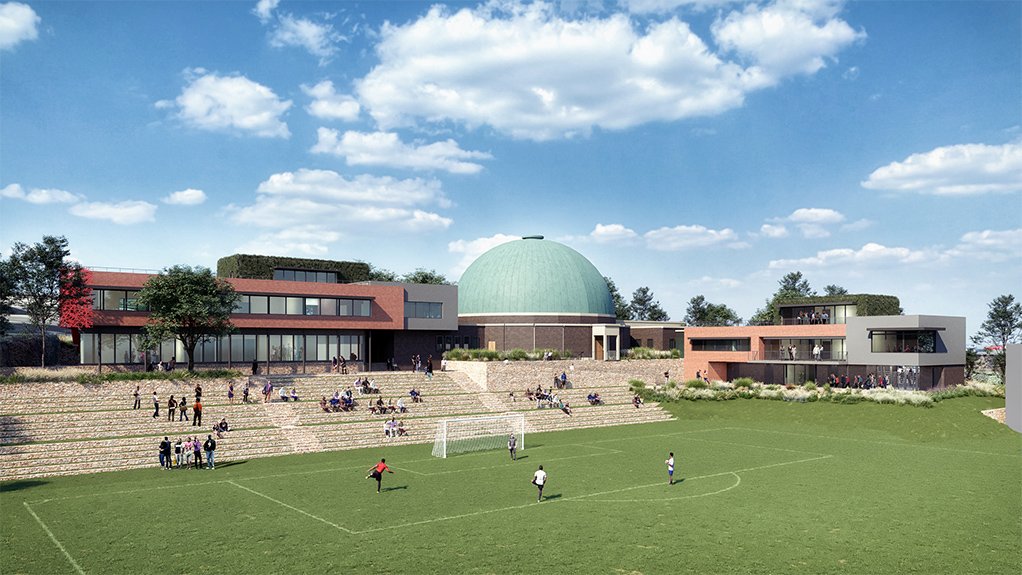The planetarium at the University of the Witwatersrand (Wits), which is 62 years old this year, is being modernised into a fully fledged multidisciplinary science, research and education hub that is open to the public, learners, students and researchers.
The project has received R20-million in funding from the Wits council and a R55-million donation from mining multinational Anglo American Group, and will be named the Wits Anglo American Digital Dome. It will be built during the next year and will open in 2024.
"The Digital Dome will provide a high-technology theatre-like experience and will assist researchers across all disciplines to visualise data in a profound way," Wits Centre for Astrophysics director and Square Kilometre Array (SKA) Chair in Radioastronomy Professor Roger Deane highlighted at the launch of the project on November 21.
In the first stage of the project, the planetarium will be refurbished and digitalised. A circular high-resolution digital projection system will serve as the heart of the Science and Technology Exploratorium.
This modern planetarium system will be able to display the six astronomy shows donated by Wits' long-term collaboration partner the American Museum of Natural History in New York. The shows cost about R1-million each to produce; however, the aim of the Digital Dome is to eventually produce its own astronomy and science shows, said Wits Faculty of Science dean Professor Nithaya Chetty.
The Digital Dome will enable researchers to map multi-layered biodiversity data, as well as sensitivity to human activity, such as climate change, and inspire new ways of visualising and presenting complex datasets, said Anglo CE Duncan Wanblad.
The facility, designed by artificial intelligence researchers, scientists, digital artists and quantum computing engineers, will provide access to the public to explore the universe through telescopes, such as the SKA, with seamless simulations of the evolution of galaxies, stars and black holes.
"The new Wits Anglo American Digital Dome will be a world-class and accessible centre that will inspire generations to take an active interest in science, technology, engineering and mathematics disciplines and the digital arts," Wanblad said.
The transformation of the planetarium aligned with Anglo's purpose to reimagine mining to improve people's lives. The company had a multidisciplinary role in society and must undertake multidisciplinary functions to improve people's lives, he added.
"The Digital Dome is, therefore, a useful metaphor for the rapid evolution of mining locally and globally, and aims to tell the story of new beginnings and advances not only in mining sciences but also in South Africa's economy and society. Investment in education will lead to change and betterment of society," Wanblad said.
The planetarium will be transformed into a high-technology, research-intensive facility that will enable future generations to aspire, be curious and inventive, and contribute to solving society's most pressing challenges.
"The world is in a time of unprecedented disruption, with the amount of data exploding. Analysing large datasets is a fundamental basis for competition, and will underpin new waves of growth and innovation," Wanblad emphasised.
The second stage of the Digital Dome project will involve the construction of a north wing, which will have a suite of operational offices, an exhibition area, a seminar room and meeting space for Digital Dome show planning and design, said Deane.
Further, the third stage, which is currently unfunded, envisages the construction of a research-focused east wing that will have open-plan office space for visiting research teams to interface with in-house data visualisation and show rendering experts.
"The value of the [planetarium] building goes beyond infrastructure. It serves as a source of inspiration for young people, much like I was inspired in 1981 after visiting the planetarium days after the first space shuttle launch to become a scientist and leader of this instituion," commented Wits vice-chancellor Professor Zeblon Vilakazi.
While Digital Dome will be able to transport 270 visitors to different worlds and galaxies, it will also allow researchers, students, learners and citizens to imagine and visualise new ways of learning and living, and inspire them in these troubled times as a country and as a world to change society for good, he said.
"The Digital Dome is a perfect example of what is possible when we work together. Many of the shared projects between us and Anglo American have the common objective of developing high-level skills for the digital economy in the digital age.
"We will co-create intellectual property and harness data to not only make mining safer and more sustainable, but most importantly to build communities that prosper," Vilakazi noted.
Meanwhile, the existing projector, the still operational 92-year-old German-made Zeis Mark 3 (although it started as a Mark 2 and was upgraded), will be removed and preserved. It could display 8 000 points of light onto the dome, which was an accurate depiction of the brightest stars in the night sky and the motions of the planets.
The new digital projection system will enable not only the display of the 100-billion stars within the Milky Way, but also enable show creators to let viewers visit stellar nurseries, other galaxies – each with billions of stars – and to orbit distant planets and get a new perspective of Earth as viewed from other celestial bodies, highlighted Deane.
EMAIL THIS ARTICLE SAVE THIS ARTICLE ARTICLE ENQUIRY
To subscribe email subscriptions@creamermedia.co.za or click here
To advertise email advertising@creamermedia.co.za or click here











